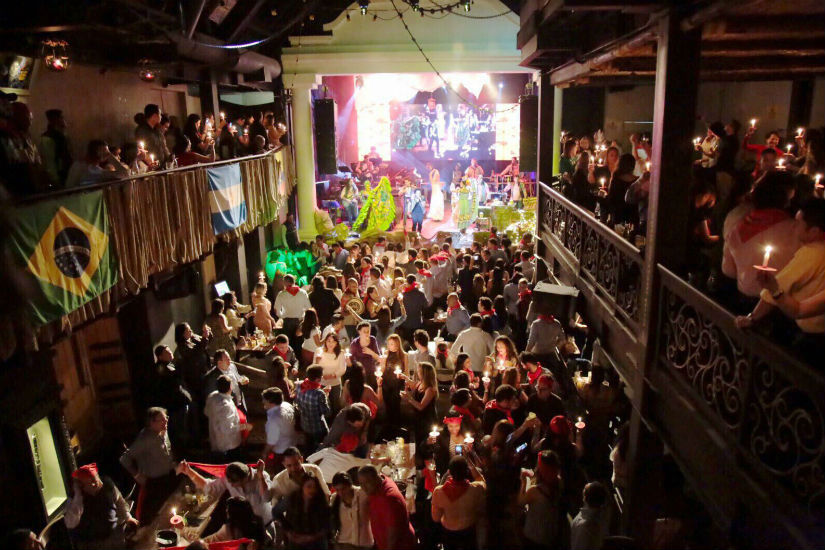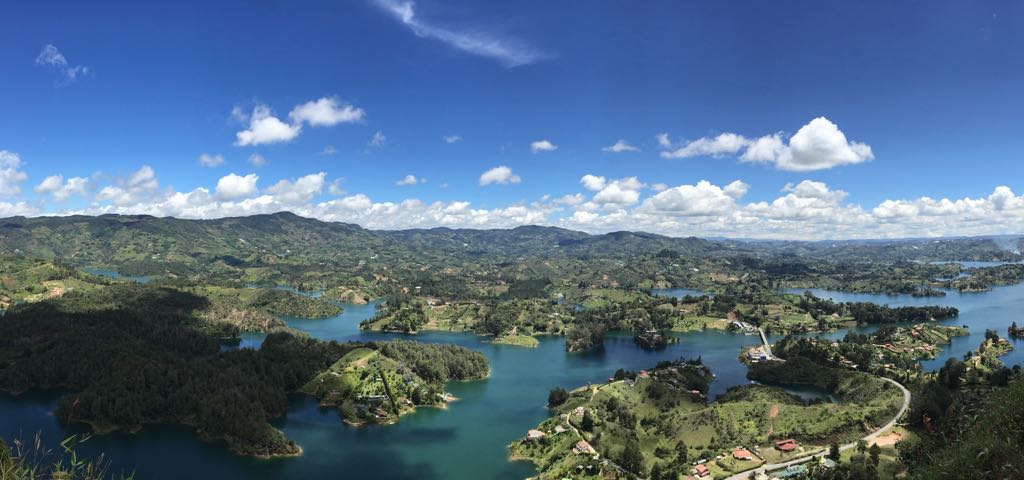
Colombia’s capital city of Bogota is a vast, sprawling place with a population of over 8 million people, and concrete as far as the eye can see. It’s a great city to visit,cradled by the chilly Andean peaks on one side and steeped in sophisticated urban cool on the other. The city’s cultural epicenter is La Candelaria, the cobbled historic downtown to which most travelers gravitate. Here, a potpourri of preciously preserved colonial buildings house museums, restaurants, hotels and bars peppered amid 300-year-old homes, churches and convents. Nearly all of Bogotá’s traditional attractions are here – radiating out from Plaza de Bolívar – and gorgeous Cerro de Monserrate is just east.

1. Candelaria
The Candelaria is the colorful, historic district of Bogotá. Walking along the Candelaria reminds me of walking down the streets of Spain because of the colonial architecture and the colourful painted buildings.

2. Museo Botero
The highlight of Banco de la República’s large museum complex is several halls spread over two floors dedicated to all things chubby: hands, oranges, women, mustached men, children, birds, Fuerzas Armadas Revolucionarias de Colombia (FARC) leaders. All of these are, of course, the robust paintings and sculptures of Colombia’s most famous artist, Fernando Botero (Botero himself donated these works). Having seen a Botero statue in Singapore and sculptures in Armenia, I was really interested to visit this museum to see more of his artworks. Surprisingly, entrance is free and the art galleries are well-maintained.


3. Plaza de Bolivar
The usual place to start discovering Bogotá is Plaza de Bolívar, the heart of the original town. In the middle of the square is a bronze statue of Simón Bolívar (cast in 1846), the work of Italian artist Pietro Tenerani. This was the first public monument erected in the city. Simon Bolivar was a Venezuelan military leader who tried to unite the whole continent to form the Gran Colombia but it did not work out. In the center of the square, beside the 1846 bronze statue of Bolívar are flocks of pigeons that dive-bomb anyone within 50m of the square – a hat is a good idea.


4. Capitolio Nacional
On the southern side of the plaza stands this neoclassical seat of Congress. It was begun in 1847, but due to numerous political uprisings was not completed until 1926. Its square-facing facade was built by English architect Thomas Reed. There is a way to enter this building if you write in to the authority in advance.

5. Botanical Garden (Jardin Botanico)
This park is the biggest Colombian botanical garden as well, so if you come to Colombia it’s a must see. You will be stunned by its quantity of flora and fauna, the fresh environment you can breathe because of its large amount of trees and pure water. Your eyes won’t believe so much beauty. For a quiet day, come here to find different places of the park to get some rest, to drink a coffee, to watch close the variety of fishes, ducks, peacocks, pigeons, and other animals and also to sleep on the grass. The best of all is that you will feel that you can have a day without all that noise and pollution that is always found in the city.

6. Cerro Montserrate
The best views of Bogotá’s urban sprawl can be seen from the heights of nearby Montserrate —3140 metres above sea level — located right on the edge of the busy city center. You can easily reach the top by funicular or cable car, or those wanting a steep hike can walk right up. For those who want to hike up, do take note that the hiking path is closed for entrance from 1pm onwards. Once you reach the top, you’ll find a church, restaurant, snack bar, complex of small shop and souvenir stands and, of course, epic views of Bogotá and beyond.

7. Paloquemao Square
Paloquemao Square, in the west of Bogotá, is a traditional part of the city where fresh vegetables and other farm products fill an old abandoned railroad warehouse with color. The square, in operation since 1972, is much more than a marketplace, and attracts Colombian and foreign visitors who find a wide variety of fruit. Visitors often receive free samples of fruits from the friendly vendors, never mind if you cannot speak Spanish.

8. Museo de Oro (Gold museum)
At the Banco de la República’s Gold Museum, visitors witness an unforgettable experience: as they stand in a dark room, bright lights suddenly switch on to reveal hundreds of gold ornaments. The museum features about 13,000 gold artifacts and 20,000 stone and clay objects originating from various pre-Hispanic cultures. The amount of golden objects in the museum will leave you stunned.

9. Santuario Nestra Señora del Carmen
This is one of the most beautiful and historic Catholic churches in Bogotá, dedicated to the Virgin Mary. Located in La Candelaria, it was consecrated in 1938 and is known for its gothic, Florentine style. The red and white horizontal stripes that line both the inside and outside are hard to miss and forget. Be sure to look inside at the elaborately painted interior. Unlike most cathedrals, there isn’t as much gold as there is red, blue and white.









10. Taking the Transmilenio
While this does not exactly count as an attraction, I must admit that I am impressed with the Transmilenio from the first time I took it from the airport to town. It is the world’s first bus rapid transit (BRT), consisting of several interconnected BRT lines, with raised floor stations in the center of a main avenue, or “troncal”. Passengers typically reach the stations via a bridge over the street. There are two bus lanes going in each direction that are dedicated to bus traffic, so it is much faster to take the bus as it is not caught in traffic. Bus doors are also raised so their opening can match the height of the platform, working somewhat in the form of a metro. It is a cost-efficient method to improve the public transport system as building an underground metro system would take years and cost more.

These are 10 good reasons on why you should visit Bogota. While most people fly into Bogota as their first port of entry, this was our last one and we only had two full days to explore the whole city. Hope to return again because we missed out on the chance to visit the nearby underground salt cathedral and other national parks.




